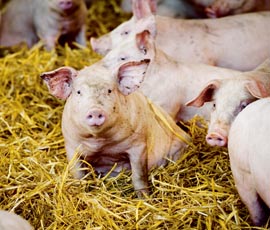Plan for for straw shortage, farmers urged

Livestock producers are being warned to start planning for predicted straw shortages following an unusually dry spring.
The south and east have been particularly hard hit, with only 30% of the rain typically seen this spring, according to Met Office figures. Colin Stone, BPEX knowledge transfer manager, reports there is virtually no old crop barley straw for sale in East Anglia, with wheat straw only available to farmers willing to travel.
“The drought in East Anglia means straw yield will be significantly down – in some crops by as much as 25%,” he said. “As a result, many pig producers are keen to buy straw by the number of bales produced rather than by the acre, and may also be looking to reduce straw usage and reduce wastage.”
Pig farmer Richard Longthorp, who farms outdoor pigs in east Yorkshire, said on his own arable acreage the volume would be down.
“As a result, we are going to sheet all the straw to make sure it takes the bulk of rain and not a top layer of straw.”
Wiltshire pig producer Cameron Naughton is also experiencing a shortage, with just one month’s worth of straw left in the barn. “There’s no carry-over this year because of the early winter and the fact last year’s crops weren’t particularly high yielding.
“Although the crops are looking better than they were a month ago, when you walk them they look thin and I reckon we will be at least 20% down on yield.”
When asked about how he would cope with the shortage, given the fact he uses more than 405ha (1,000 acres) of straw a year, Mr Naughton said one option may be to reduce numbers. “If we were making money on our pigs we could afford alternative bedding, but we are currently loosing money and have to look seriously at the job.”
However, producers could stretch straw stocks by minimising dunging areas, ensuring good drainage, avoiding unnecessary spills from feeders and drinkers and storing straw correctly. Mr Stone said the use of straw choppers on outdoor pig units could also help reduce usage by delivering straw to pens little and often.
For cattle, extending the grazing period for stock that do not have high feed requirements could help reduce pressure on housing and straw. EBLEX beef and sheep scientist, Mary Vickers, said it may also be worth considering feeding beef cattle that are nearly ready for sale at grass to reduce the amount of time they will be required to finish inside and to prioritise bedding for animals close to finishing so they remain clean.
“It may also be worth chatting to your straw supplier to see whether they would be interested in a straw-for-muck deal. Instead of arable producers getting soil nutrients back from chopped straw, they can get it back from muck.”
However, Dr Vickers did express some caution when considering alternative bedding. “It’s important to think long term. While straws such as pea and bean can be used, they may make a better drainage layer, with cereal straw on top. If using a waste product such as paper it is also important to be aware of waste regulations and disposal, so it may be worth contacting the Environment Agency.”
